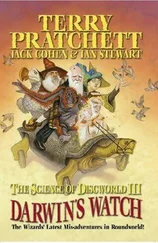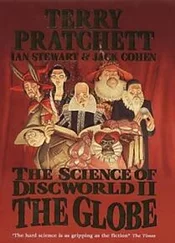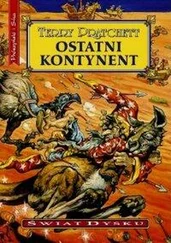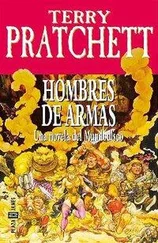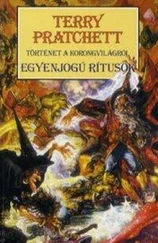Terry Pratchett - Science of Discworld
Здесь есть возможность читать онлайн «Terry Pratchett - Science of Discworld» весь текст электронной книги совершенно бесплатно (целиком полную версию без сокращений). В некоторых случаях можно слушать аудио, скачать через торрент в формате fb2 и присутствует краткое содержание. Жанр: Фантастика и фэнтези, на английском языке. Описание произведения, (предисловие) а так же отзывы посетителей доступны на портале библиотеки ЛибКат.
- Название:Science of Discworld
- Автор:
- Жанр:
- Год:неизвестен
- ISBN:нет данных
- Рейтинг книги:4 / 5. Голосов: 1
-
Избранное:Добавить в избранное
- Отзывы:
-
Ваша оценка:
- 80
- 1
- 2
- 3
- 4
- 5
Science of Discworld: краткое содержание, описание и аннотация
Предлагаем к чтению аннотацию, описание, краткое содержание или предисловие (зависит от того, что написал сам автор книги «Science of Discworld»). Если вы не нашли необходимую информацию о книге — напишите в комментариях, мы постараемся отыскать её.
Science of Discworld — читать онлайн бесплатно полную книгу (весь текст) целиком
Ниже представлен текст книги, разбитый по страницам. Система сохранения места последней прочитанной страницы, позволяет с удобством читать онлайн бесплатно книгу «Science of Discworld», без необходимости каждый раз заново искать на чём Вы остановились. Поставьте закладку, и сможете в любой момент перейти на страницу, на которой закончили чтение.
Интервал:
Закладка:
Does Great A'Tuin, the turtle that holds up the elephants that hold up the Disc, swim through the depths of space in search of a distant light? Perhaps. According to The Light Fantastic, 'Philosophers have debated for years about where Great A'Tuin might be going, and have often said how worried they are that they might never find out. They're due to find out in about two months. And then they're really going to worry ...' For, like its earthbound counterpart, Great A'Tuin is in reproductive mode, in this case going to its own hatching ground to watch the emergence. That story ends with it swimming off into the cool depths of space, orbited by eight baby turtles (who appear to have gone off on their own, and perhaps even now support very small Discworlds) ...
The interesting thing about the terrestrial turtlish trickery is that at no stage is it necessary for the animals to be conscious that their timing is geared to the Moon's motion, or even that the Moon exists. However, the trick won't work unless the baby turtles notice the Moon, so we deduce that they did. But we can't deduce the existence of some turtle astronomer who wondered about the Moon's puzzling changes of shape.
When a particular bunch of social-climbing monkeys arrived on the scene, however, they began to ask such questions. The better the monkeys got at answering those questions, the more baffling the universe became; knowledge increases ignorance. The message they got was: Up There is very different from Down Here.
They didn't know that Down Here was a pretty good place for creatures like them to live. There was air to breathe, animals and plants to eat, water to drink, land to stand on, and caves to get out of the rain and the lions. They did know that it was changeable, chaotic, unpredictable ...
They didn't know that Up There, the rest of the universe, isn't like that. Most of it is empty space, a vacuum. You can't breathe vacuum. Most of what isn't vacuum is huge balls of overheated plasma. You can't stand on a ball of flame. And most of what isn't vacuum and isn't burning is lifeless rock. You can't eat rock. They were going to learn this later on. What they did know was that Up There was, in human timescales, calm, ordered, regular. And predictable, too, you could set your stone circle by it.
All this gave rise to a general feeling that Up There was different from Down Here for a reason. Down Here was clearly designed for us. Equally clearly, Up There wasn't. Therefore it must be designed for somebody else. And the new humanity was already speculating about some suitable tenants, and had been ever since they'd hidden in the caves from the thunder. The gods! They were Up There, looking Down! And they were clearly in charge, because humanity certainly wasn't. As a bonus, that explained all of the things Down Here that were a lot more complicated than anything visible Up There, like thunderstorms and earthquakes and bees. Those were under the control of the gods.
It was a neat package. It made us feel important. It certainly made the priests important. And since priests were the sort of people who could have your tongue torn out or banish you into Lion Country for disagreeing with them, it rapidly became an enormously popular theory, if only because those who had other ones either couldn't speak or were up a tree somewhere.
And yet ... every so often some lunatic with no sense of self-preservation was born who found the whole story unsatisfying, and risked the wrath of the priesthood to say so. Such folk were already around by the time of the Babylonians, whose civilization flourished between and around the Tigris and Euphrates rivers from 4000 BC to 300 BC. The Babylonians, a term that covers a whole slew of semi-independent peoples living in separate cities such as Babylon, Ur, Nippur, Uruk, Lagash, and so on, certainly worshipped the gods like everyone else. One of their stories about gods is the basis of the Biblical tale of Noah and his ark, for instance. But they also took a keen interest in what those lights in the sky did. They knew that the Moon was round, a sphere rather than a flat disc. They probably knew that the Earth was round, too, because it cast a rounded shadow on the Moon during lunar eclipses. They knew that the year was about 365 1/4 days long. They even knew about the 'precession of the equinoxes', a cyclic variation that completes one cycle every 26,000 years. They made these discoveries by keeping careful records of how the Moon and the planets moved across the sky. Babylonian astronomical records from 500 BC survive to this day.
From such beginnings, an alternative explanation of the universe came into being. It didn't involve gods, at least directly, so it didn't find much favour with the priestly class. Some of their descendants are still trying to stamp it out, even today. The traditional priesthoods (who then and now often included some very intelligent people) eventually worked out an accommodation with this godless way of thinking, but it's still not popular with postmodernists, creationists, tabloid astrologers and others who prefer the answers you can make up for yourself at home.
The current name for what has variously been called 'heresy' and 'natural philosophy' is, of course, 'science'.
Science has developed a very strange view of the universe. It thinks that the universe runs on rules. Rules that never get broken. Rules that leave little room for the whims of gods.
This emphasis on rules presents science with a daunting task. It has to explain how a lot of flaming gas and rocks Up There, obeying simple rules like 'big things attract small things, and while small things also attract big things they don't do it strongly enough so as you'd notice', can have any chance whatsoever of giving rise to Down Here. Down Here, rigid obedience to rules seems notably absent. One day you go out hunting and catch a dozen gazelles; next day a lion catches you. Down Here the most evident rule seems to be 'There are no rules', apart perhaps from the one that could be expressed scientifically as 'Excreta Occurs'. As the Harvard Law of Animal Behaviour puts it: 'Experimental animals, under carefully controlled laboratory conditions, do what they damned well please.' Not only animals: every golfer knows that something as simple as a hard, bouncy sphere with a pattern of tiny dots on it never does what it's supposed to do. And as for the weather ...
Science has now divided into two big areas: the life sciences, which tell us about living creatures, and the physical sciences, which tell us about everything else. Historically, 'divides' is definitely the word, the scientific styles of these two big divisions have about as much in common as chalk and cheese. Indeed, chalk is a rock and so clearly belongs to the geological sciences, whereas cheese, formed by bacterial action on the bodily fluids of cows, belongs to the biological sciences. Both divisions are definitely science, with the same emphasis on the role of experiments in testing theories, but their habitual thought patterns run along different lines.
At least, until now.
As the third millennium approaches, more and more aspects of science are straddling the disciplines. Chalk, for instance, is more than just a rock: it is the remains of shells and skeletons of millions of tiny ocean-living creatures. And making cheese relies on chemistry and sensor technology as much as it does on the biology of grass and cows.
The original reason for this major bifurcation in science was a strong perception that life and non-life are extremely different. Non-life is simple and follows mathematical rules; life is complex and follows no rules whatsoever. As we said, Down Here looks very different from Up There.
Читать дальшеИнтервал:
Закладка:
Похожие книги на «Science of Discworld»
Представляем Вашему вниманию похожие книги на «Science of Discworld» списком для выбора. Мы отобрали схожую по названию и смыслу литературу в надежде предоставить читателям больше вариантов отыскать новые, интересные, ещё непрочитанные произведения.
Обсуждение, отзывы о книге «Science of Discworld» и просто собственные мнения читателей. Оставьте ваши комментарии, напишите, что Вы думаете о произведении, его смысле или главных героях. Укажите что конкретно понравилось, а что нет, и почему Вы так считаете.



